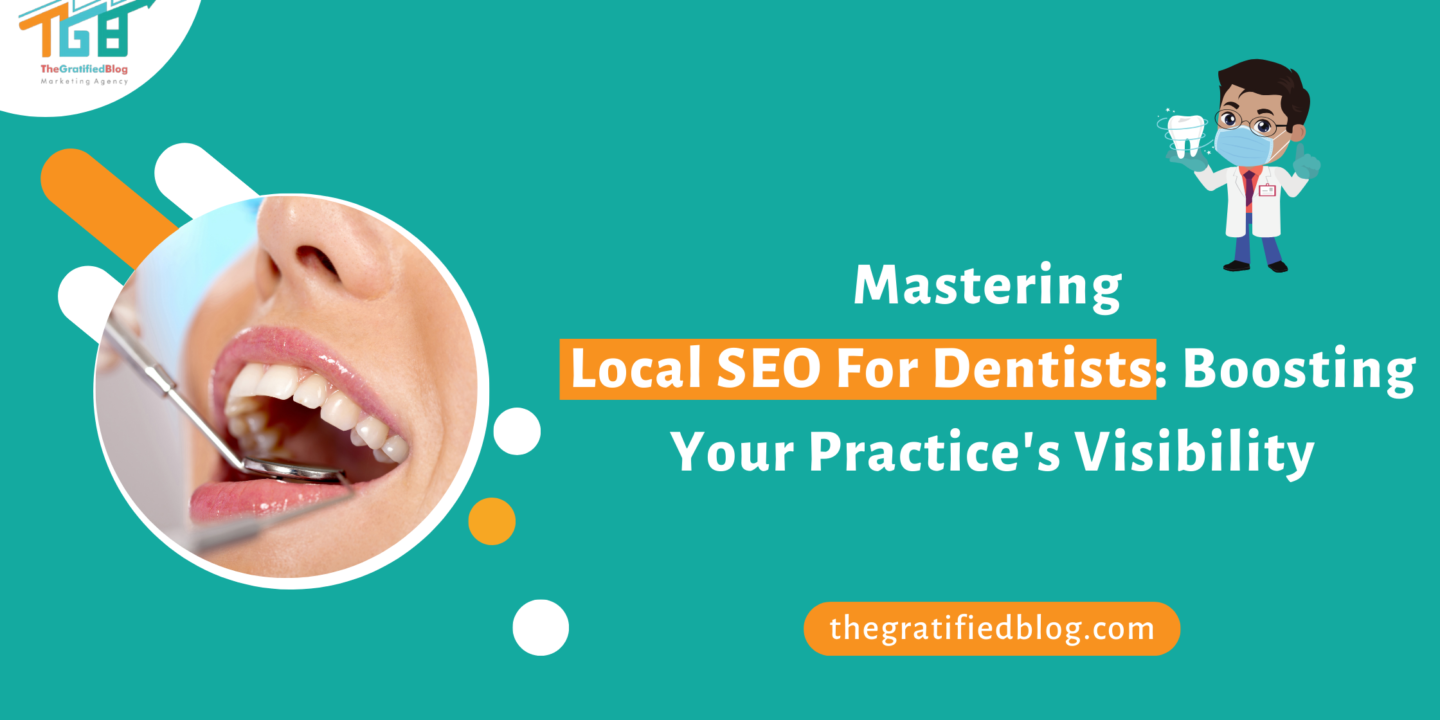
In today’s digital age, when individuals seek solutions to their dental concerns, where do they turn? The answer lies in the palm of their hands—literally. In the era of smartphones and online searches, local businesses, including dental practices, need to harness the power of the web to stay relevant and accessible to their communities. That is where Local SEO for dentists comes into play.
This extensive guide will explore the intricacies of “Local SEO for Dentists.” We’ll explore the essential concepts, strategies, and techniques that can help your dental practice climb the search engine rankings, attract more local patients, and, ultimately, thrive in an increasingly competitive healthcare landscape.
So, let’s get started.
What Makes “Local SEO For Dentists” Crucial?
Before we dive into the nitty-gritty of local SEO ranking factors for dentists, let’s first understand why local SEO is paramount for dental practices:
In an era where the internet is the primary resource for individuals seeking healthcare services, including dental care, local SEO has become an indispensable tool for dentists. Here’s why it matters:
- Accessibility and Visibility: Most potential patients search engines like Google to find local dental services. By optimizing your online presence, you ensure that your practice is visible to those actively seeking dental care in your area.
- Competitive Edge: You will likely face competition from other dental practices in most regions. Gaining a competitive advantage is possible through local SEO by ensuring your practice appears at the top of search results when potential patients seek dental services.
- Cost-Effective Marketing: Unlike traditional advertising methods, local SEO offers a cost-effective way to market your dental practice. It targets users interested in your services, making your marketing efforts more efficient and cost-friendly.
- Trust and Credibility: A well-optimized online presence, including positive reviews and accurate information, helps build trust and credibility with potential patients. People are more likely to choose a dental practice that appears professional and reliable online.
Now that we’ve established why local SEO is crucial for dentists, let’s explore the critical local SEO ranking factors specific to dental practices
Key Local SEO Ranking Factors For Dentists
Successful local SEO for dentists relies on a combination of strategies and techniques. Here are the five key ranking factors that can significantly impact your dental practice’s online visibility:
- Google My Business (GMB) Optimization
- Local Link Building
- Online Reviews and Reputation Management
Now, let’s delve deeper into each of these factors to gain a comprehensive understanding of their importance and how they contribute to local SEO success.
Optimizing Your Google My Business Listing
Your Google My Business (GMB) listing is a powerful tool for attracting local patients and boosting your dental practice’s visibility. You need to optimize your GMB profile effectively to make the most of it.
Here are the key steps to ensure your GMB listing is in top shape:
A. Completing Your GMB Profile
Your GMB profile serves as a digital storefront for your dental practice. Completing it with accurate and detailed information is the first step to success. Here’s what you should do:
- Claim and Verify Your Listing: If you still need to, claim ownership of your GMB listing and go through the verification process. This step is crucial for gaining control over your listing and ensuring its accuracy.
- Provide Accurate Business Information: Make sure your business name, address, and phone number (NAP) are consistent with the information on your website and across the web. Consistency is vital for local SEO.
- Select the Right Categories: Choose the most relevant categories for your dental practice. Use specific categories like “Dentist” and “Cosmetic Dentistry” to help Google understand your services better.
- Add Detailed Business Description: Craft a concise but informative business description. Highlight your dental specialties, services, and what sets your practice apart from competitors.
- Include Operating Hours: Specify your dental office’s regular operating hours and update them for holidays or special occasions.
- Add Appointment Links: If you offer online appointment booking, include links to your scheduling platform for user convenience.
B. Adding High-Quality Photos and Videos
The use of visual content can have a substantial influence on potential patients. Use the following tips for adding photos and videos to your GMB profile:
- Profile Photo: Use a high-resolution image of your dental practice’s exterior as the profile photo. This helps patients recognize your location.
- Cover Photo: Showcase the interior of your clinic or waiting area in the cover photo to provide a welcoming impression.
- Additional Photos: Upload clear, well-lit photos of your dental team, treatment rooms, equipment, and any special features of your practice.
- Videos: Consider creating short videos introducing your team, showcasing dental procedures, or providing tips for dental care. Videos can engage potential patients effectively.
C. Encouraging Customer Reviews
Positive reviews on your GMB listing boost your online reputation and influence potential patients. Here’s how to encourage customer reviews:
- Ask Satisfied Patients: Politely ask satisfied patients to leave reviews on your GMB listing. You can do this in person, through follow-up emails, or by adding a review request link to your website.
- Create a Review Strategy: Develop a review generation strategy that outlines when and how you’ll request reviews. Consistency is key.
D. Managing Q&A on GMB
The Q&A section on GMB can be a valuable resource for you and potential patients. Ensure it’s managed effectively:
- Monitor Regularly: Regularly check the Q&A section for questions from potential patients. Provide clear and concise answers promptly.
- Post Frequently Asked Questions: Consider posting frequently asked questions with detailed answers to address common queries proactively.
E. Responding to Reviews
Addressing both positive and negative reviews showcases your dedication to patient satisfaction. Here’s how to handle reviews effectively:
- Timely Responses: Respond to reviews as quickly as possible. Acknowledge positive feedback with gratitude and address negative feedback professionally.
- Address Concerns Privately: If a negative review requires further discussion, offer to contact the reviewer privately to resolve the issue.
F. Using Google Posts
Google Posts lets you share updates, promotions, and news directly on your GMB listing. Use them to engage potential patients:
- Regular Updates: Post regularly to keep your GMB listing fresh and engaging. Share information about new services, special offers, or dental tips.
- Use Eye-Catching Visuals: Include images and eye-catching visuals to make your posts more appealing.
Local Link-Building Strategies
Local SEO relies significantly on the essential aspect of link-building for dentists. It boosts your website’s authority and helps establish your dental practice as a trusted and reputable local business. Here are effective local link-building strategies tailored for dental practices:
A. Building Local Citations
Local citations are online mentions of your dental practice’s name, address, and phone number (NAP) on various websites and directories. They play a significant role in local SEO. Here’s how to build local citations effectively:
- Claim Local Directory Listings: Start by claiming and optimizing your listings on popular online directories such as Google My Business, Yelp, Bing Places, Yellow Pages, and Healthgrades. Ensure that your NAP information is accurate and consistent across all platforms.
- Explore Industry-Specific Directories: Look for dental and healthcare-related directories where you can list your practice. These directories often attract patients seeking specific services.
- Local Citations in Blog Posts: When you contribute guest blog posts, ensure that your NAP information is included in your author bio or relevant content.
- Monitor Citations: Regularly monitor your citations to ensure they remain accurate and up-to-date. Tools like Moz Local and Yext can help with citation management.
B. Obtaining Backlinks from Local Businesses
Backlinks from local businesses can significantly boost your website’s authority and local relevance. Here’s how to obtain them:
- Build Relationships: Network with local businesses, especially those in related fields like orthodontists, periodontists, or dental suppliers. Establishing relationships can lead to natural backlink opportunities.
- Collaborate on Content: Consider collaborating with local businesses on content projects. For instance, you could co-create dental health guides or host joint events, which can lead to backlinks from their websites.
- Sponsorships and Partnerships: Sponsor local events or partner with local charities. Many of these organizations will acknowledge your sponsorship with a backlink on their website.
- Local Press and News: Ensure your website is linked whenever your practice is featured in local news or press releases. Local media outlets often include website links in their coverage.
Online Reviews And Reputation Management

Online reviews and reputation management are pivotal for dentists in the digital age. Your patients’ opinions expressed through reviews can significantly influence your practice’s success.
Here’s how to navigate this crucial aspect of local SEO for dentists:
A. The Impact of Online Reviews on Local SEO
Understanding the profound impact of online reviews on local SEO is the first step in harnessing their power:
- Search Engine Ranking: Google and various other search engines take online reviews into account when ranking local businesses. Practices with a higher number of positive reviews often rank higher.
- Click-Through Rates: Positive reviews can lead to higher click-through rates (CTR) in search results. A well-reviewed practice is more likely to attract clicks from potential patients.
- Conversion Rates: Patients often trust reviews as much as personal recommendations. Higher conversion rates can result from positive reviews because prospective patients are more likely to choose your practice.
- Local Pack Visibility: Good reviews can increase your likelihood of appearing in the sought-after “Local Pack” or “3-Pack” of Google’s search results, which prominently displays local businesses.
B. Encouraging Happy Patients to Leave Reviews
Proactively encouraging satisfied patients to leave reviews can help boost your online reputation. Here’s how to go about it:
- Ask for Reviews: Train your staff to ask patients for reviews, especially after successful appointments. Consider including a review request in follow-up emails.
- Make It Easy: Provide patients with clear instructions on how to leave reviews on platforms like Google, Yelp, and Facebook. Offer direct links if possible.
- Create Review Request Cards: Design and distribute review request cards with a QR code or URL for easy access to review platforms.
- Utilize Email Campaigns: Send email campaigns requesting reviews from patients who have recently visited your practice. Keep the process straightforward.
C. Handling Negative Reviews Professionally
Negative reviews are unavoidable, but your response to them can mitigate their impact. Here’s how to handle negative reviews professionally:
- Stay Calm and Objective: Never respond emotionally or defensively to negative reviews. Approach each response with professionalism and empathy.
- Address the Issue Privately: If possible, offer to resolve the issue privately by providing your contact information or inviting the reviewer to contact you directly.
- Show Empathy: Express empathy for the patient’s experience and apologize if they had a negative one. Demonstrating your commitment to improving patient satisfaction is essential.
- Highlight Positive Aspects: If appropriate, highlight the positive aspects of your practice, such as your commitment to patient care or any actions you’ve taken to address the issue.
D. Monitoring and Managing Your Online Reputation
Active monitoring and management of your online reputation are crucial for maintaining a positive image:
- Use Online Reputation Management Tools: Consider using online reputation management tools that aggregate and track reviews from various platforms.
- Set Up Google Alerts: Set up Google Alerts for your practice name so you’re notified whenever your practice is mentioned online.
- Respond Promptly: Respond to reviews promptly, whether positive or negative. This shows your engagement and commitment to patient feedback.
- Request Edits for Inaccurate Information: If you need more accurate review information (e.g., outdated contact details), kindly ask the reviewer to edit it.
- Social Media Monitoring: It involves keeping tabs on various monitored social media platforms for references to your practice. Respond to any comments or messages promptly.
Having explored the essential local SEO ranking factors for dentists, the next step is to delve into the methods for tracking and assessing the effectiveness of your local SEO efforts.
Tracking And Measuring Local SEO Success
Tracking and measuring various metrics is essential to assess the efficiency of your local SEO endeavors and implement adjustments as needed for data-driven improvements. Here’s how to do it:
Monitoring GMB Insights
Google My Business (GMB) Insights offers valuable data about how users interact with your listing:
- User Actions: Monitor how users interact with your GMB listing, including clicks for directions, calls, and website visits.
- Search Queries: Identify the search terms that led users to your listing. Use this information to optimize your content.
- Photo and Video Views: Track the engagement with photos and videos on your GMB listing.
Tracking Keyword Rankings
Regularly tracking your keyword rankings aids in comprehending the effectiveness of your website in search result outcomes:
- Keyword Tracking Tools: Use SEO tools like SEMrush or Ahrefs to monitor your keyword rankings. Set up tracking for relevant dental keywords.
- Monitor Local Rankings: Focus on local keyword rankings to see your performance in your service area.
Measuring Website Traffic And Conversion Rates
- Traffic Analysis: Analyze website traffic using Google Analytics. Pay attention to the number of visitors, their demographics, and how they navigate your site.
- Conversion Tracking: Set up conversion tracking for essential actions on your website, such as appointment bookings or contact form submissions. This helps you measure the effectiveness of your website in converting visitors into patients.
- Goal Tracking: Define specific goals in Google Analytics, such as “Request an Appointment” or “Call Us.” Monitor the completion of these goals to assess your website’s performance.
Now that we’ve discussed the techniques to track and gauge the success of your local SEO efforts let’s turn our attention to valuable tips and best practices in this domain.
Tips And Best Practices
To ensure your local SEO efforts are effective and sustainable, consider these best practices:
Staying Updated With Local SEO Trends
- Continuously educate yourself about the latest developments in local SEO by following reputable SEO blogs, attending webinars, and participating in industry forums.
- Adapt your strategies to changes in search engine algorithms and user behavior.
Investing In Local SEO Tools
- Consider investing in local SEO tools like Moz Local, BrightLocal, or Whitespark to streamline your optimization efforts and gain deeper insights into your performance.
- Utilize keyword research tools and rank-tracking software to identify opportunities for improvement.
Consistency Is Key
- Maintain consistency in your NAP (Name, Address, Phone Number) information across all online platforms and directories.
- Consistently refresh your website with new and pertinent content to keep users engaged and search engines interested.
Hiring A Professional SEO Agency Vs. DIY
- Evaluate whether your local SEO efforts are best managed in-house or by partnering with a professional SEO agency. Consider factors like expertise, time, and budget constraints.
- If you opt for DIY, ensure you have the knowledge and resources to manage your local SEO strategies effectively.
Conclusion
Having acquired an in-depth comprehension of local SEO strategies tailored for dentists, it’s time to put these tools to work and leverage them to grow your dental practice within the local market.
Should you have any inquiries regarding this subject, please leave them in the comment section. We will be happy to answer you.
Thanks for reading 🙂








No Comments